4.3.4.3. three parameters/one final graph
Proposition 68
Proof 68 (89) arcs are needed to connect vertices that all belong to a given connected component. Since we have two connected components, which respectively have and vertices, this leads to the previous inequality. When is equal to one we need an extra arc.
Proposition 69
Proof 69 If and are different then they correspond for sure to at least two distinct connected components.
Proposition 70
Proof 70 Since we have at least two distinct connected components, which respectively have and vertices, this leads to the previous inequality.
Proposition 71
Proof 71 On the one hand, if , we have that . On the other hand, if , we have that (i.e., ). The result is obtained by taking the maximum value of the right-hand sides of the two inequalities.
Proposition 72
Proof 72 On the one hand, if , we have that . On the other hand, if , we have that (i.e., ). The result follows.
Proposition 73
Proof 73 On the one hand, if , we have that . On the other hand, if , we have that . Since the result follows.
Proposition 74
Proof 74 We make the proof for (the interval is only used for restricting the number of intervals to check). We have that . A forbidden interval corresponds to an interval between the end of interval and the start of the next interval . Since all intervals end before and since all intervals start after , they do not use any value in .
Proposition 75
Proof 75 On the one hand, (97) holds since the maximum number of arcs is achieved by taking connected components where each connected component is a clique involving vertices. On the other hand, (98) holds since a tree of vertices has arcs.
Proposition 76
Proof 76 The minimum number of arcs is achieved by taking one connected component with vertices and arcs as well as connected components with a single vertex and a loop.
Proposition 77
Figure 4.3.1. Illustration of Proposition 77. A graph that achieves the maximum number of arcs according to the size of the largest connected component as well as to a fixed number of vertices ()
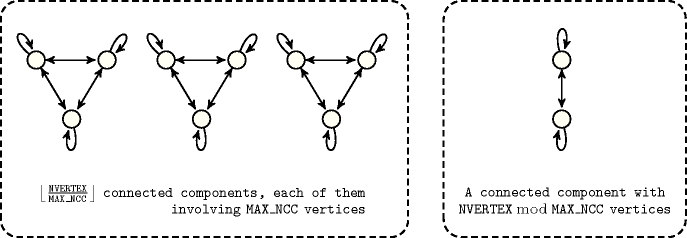
Proof 77 If we get which holds since the set of vertices is empty. We now assume that . We first begin with the following claim:
let be a graph such that , then there exists a graph such that , , and .
Proof of the claim
Let be the connected components of on less than vertices and such that . By hypothesis there exists such that and .
Either , and then with such that restricted to the be a complete graph and restricted to being exactly restricted to we obtain the claim.
Or . Then such that and (notice that ). Then with such that restricted to is a complete graph and restricted to is exactly restricted to we obtain the claim.
End of proof of the claim
We prove by induction on , where is any graph. For the result holds (see Prop 44). Otherwise, since we have that , by the previous claim there exists with the same number of vertices and the same number of vertices in the largest connected component, such that . Consequently the result holds by induction.
Proposition 78
Proof 78 Let be a graph, let be a maximal size connected component of , then we have . On the one hand, as is connected, by setting in 143 of Proposition 99, we have , on the other hand, by Proposition 52, . Thus the result follows.
Proposition 79
Proof 79 Since a connected component contains at most vertices and since it does not contain any isolated vertex a connected component involves at most sinks. Thus the result follows.
Proposition 80
Proof 80 Similar to Proposition 79.
Proposition 81
Proof 81 The number of vertices is less than or equal to the number of connected components multiplied by the largest number of vertices in a connected component.
Proposition 82
Proof 82 (105) The minimum number of vertices according to a fixed number of connected components such that one of the connected components contains vertices is obtained as follows: we get vertices from the connected component involving vertices and one vertex for each remaining connected component.
Proposition 83
Proof 83 (107) In a strongly connected component at least one arc has to leave each arc. Since we have two strongly connected components, which respectively have and vertices, this leads to the previous inequality.
Proposition 84
Proposition 85
Proof 85 Since we have at least two distinct strongly connected components, which respectively have and vertices, this leads to the previous inequality.
Proposition 86
Proof 86 Similar to Proposition 74.
Proposition 87
Proof 87 The largest number of vertices is obtained by putting within each connected component the number of vertices of the largest strongly connected component.
Proposition 88
Proof 88 Since each strongly connected component contains at most vertices the total number of vertices is less than or equal to .
Proposition 89
Proof 89 (114) The minimum number of vertices according to a fixed number of strongly connected components such that one of them contains vertices is equal to .
Proposition 90
Proof 90 (116) The maximum number of vertices according to a fixed number of vertices and to the fact that there is a connected component with vertices is obtained by:
Proposition 91
Proof 91 Achieving the minimum number of arcs with a fixed number of vertices and with a minimum number of vertices greater than or equal to one in each connected component is achieved in the following way:
Since the minimum number of arcs of a connected component of vertices is , splitting a connected component into parts that all have more than one vertex saves arcs. Therefore we build a maximum number of connected components. Since each connected component has at least vertices we get connected components.
Since we cannot build a connected component with the rest of the vertices (i.e., vertices left) we have to incorporate them in the previous connected components and this costs one arc for each vertex.
When , note that Proposition 52 provides a lower bound on the number of arcs.
Proposition 92
Proof 92 The smallest number of vertices is obtained by taking all connected components to their minimum number of vertices .
Proposition 93
Proof 93 If all vertices do not fit within the smallest connected component then we have at least two connected components.
Proposition 94
Proof 94 Achieving the maximum number of arcs, provided that we have at least one strongly connected component with vertices, is done by:
Building a first strongly connected component with vertices and adding an arc between each pair of vertices of .
Building a second strongly connected component with vertices and adding an arc between each pair of vertices of .
Finally, we add an arc from every vertex of to every vertex of . This leads to a total number of arcs of .
Proposition 95
Proof 95 The smallest number of vertices is obtained by putting within each connected component the number of vertices of the smallest strongly connected component.
Proposition 96
Proof 96 Since each strongly connected component contains at least vertices the total number of vertices is greater than or equal to .
Proposition 97
Proof 97 If all vertices do not fit within the smallest strongly connected component then we have at least two strongly connected components.
Proposition 98
Figure 4.3.2. Illustration of Proposition 98. A graph that achieves the maximum number of arcs according to a fixed number of connected components as well as to a fixed number of vertices ()
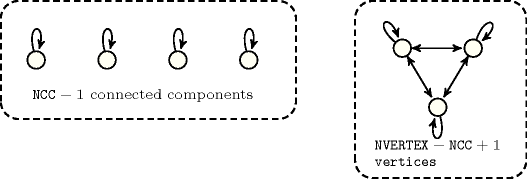
Proof 98 (133) We proceed by induction on , where is any connected component of of maximum cardinality. For then either and thus the formula is clearly true, or all the connected components of , but possibly , are reduced to one element. Since isolated vertices are not allowed, the formula holds.
Assume that . Then there exists , a connected component of distinct from , with more than one vertex. Let and let be the graph such that and is defined by:
For all connected components of distinct from and we have .
With and , we have and .
Clearly and since is of maximal cardinality the difference is strictly positive. Now as , and as the result holds by induction hypothesis.
Proposition 99
Proof 99 (143) By induction of the number of vertices. The formula holds for one vertex. Let a graph with vertices . First assume there exists in such that has the same number of connected components than . Since , and by induction hypothesis the result holds. Otherwise all connected components of are reduced to one vertex and the formula holds.
Proposition 100
Figure 4.3.3. Illustration of Proposition 100(145). A graph that achieves the maximum number of arcs according to a fixed number of strongly connected components as well as to a fixed number of vertices ()
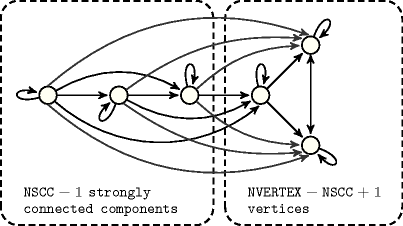
Proof 100 For proving 145, it is easier to rewrite the formula as . We proceed by induction on , where is any strongly connected component of of maximum cardinality.
For then either and thus the formula is clearly true, or all the strongly connected components of , but possibly , are reduced to one element. Since the maximum number of arcs in a directed acyclic graph of vertices is , and as the subgraph of induced by all the strongly connected components of excepted is acyclic, the formula clearly holds.
Assume that , let be the family of strongly connected components of , and let be the reduced graph of induced by (that is and , if and only if , such that ). Consider such that and is defined by:
For all strongly connected components of we have .
For be any topological sort of , , , whenever is less than with respect to .
Notice that satisfies the following properties: , , , , is still the family of strongly connected components of , and moreover, for every and every we have that is connected to any vertex outside , that is the number of arcs incident to and incident to vertices outside is exactly .
Now, as , there exists , a strongly connected component of distinct from , with more than one vertex. Let and let be the graph such that and is defined by:
.
With , we have and .
Assume that for . Then , , whenever is less than with respect to and whenever is less than with respect to .
Clearly and since is of maximal cardinality the difference is strictly positive. As , is also strictly positive. Now as , and as the result holds by induction hypothesis.
Proposition 101
Figure 4.3.4. Illustration of Proposition 147. A graph that achieves the minimum number of arcs according to a fixed number of strongly connected components as well as to a fixed number of vertices ()
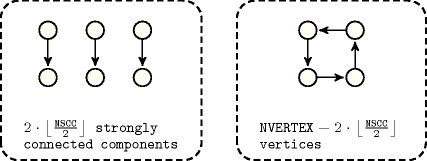
Proof 101 For proving part 147 of Proposition 101 we proceed by induction on . If then, we have (i.e., for one vertex this is true since every vertex has at least one arc, otherwise every vertex has an arc arriving on as well as an arc starting from , thus we have ). If let be a strongly connected component of . Then . By induction hypothesis , thus . Since we obtain , and thus the result holds.
Proposition 102
Proof 102 As shown in [BessiereHebrardHnichKiziltanWalsh05], a lower bound for the minimum number of equivalence classes (e.g., strongly connected components) is the independence number of the graph and the right-hand side of Proposition 102 corresponds to a lower bound of the independence number proposed by Turán [Turan41].
Proposition 103
Proof 103 See [Hansen75] and [FavaronMaheoSacle88].
Proposition 104
Proof 104 The maximum number of arcs is achieved by the following pattern: for all non-sink vertices we have an arc to all vertices.
Proposition 105
Figure 4.3.5. Illustration of Proposition 105. Two graphs that achieve the minimum number of arcs according to a fixed number of sinks as well as to a fixed number of vertices: (A) ; (B) .
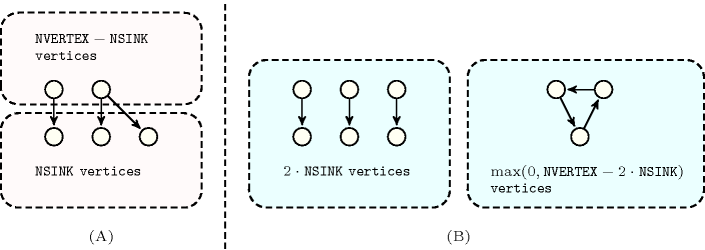
Proof 105 Recall that for , we have that . If is a sink then , consequently . If is not a sink then , consequently .
Proposition 106
Proof 106 The maximum number of arcs is achieved by the following pattern: for all non-source vertices we have an arc from all vertices.
Proposition 107
Figure 4.3.6. Illustration of Proposition 107. Two graphs that achieve the minimum number of arcs according to a fixed number of sources as well as to a fixed number of vertices: (A) ; (B) .
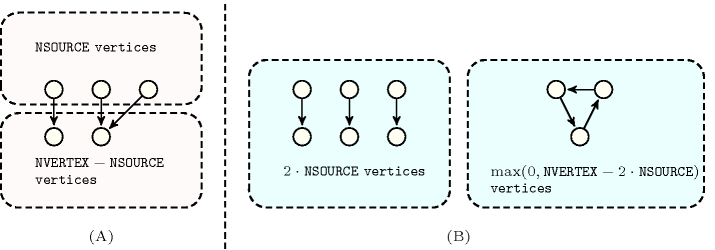
Proof 107 Similar to Proposition 105.
Proposition 108
Proof 108 Since sinks and sources cannot belong to a circuit and since they cannot coincide (i.e., because isolated vertices are not allowed) the result follows.
Proposition 109
Proof 109 No vertex can be both a source and a sink (isolated vertices are removed).